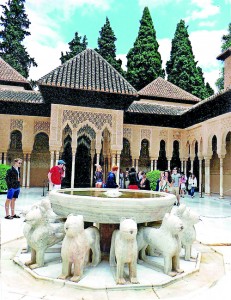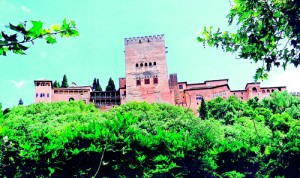Reliving the splendour and legends surrounding Alhambra
The finest example of Islamic art is the Alhambra (Red Castle), the main attraction of Granada set against the Sierra Nevada hills.
The previous night we had driven past the complex to the Sacromonte caves for a performance of flamenco dancing by the gypsies.The Spanish gypsies are believed to have come from Africa in medieval times bringing with them a blend of culture with a mix of Moorish, Jewish and Indian origins. Over the centuries their dances, and melodies have gradually blended with those of passionate Andalusia.The atmosphere seated in the illuminated cave of the gypsies (now serving as a dance studio) and watching the hand movements and foot work of the gypsies as they went through their routines personifying life, and joy was fascinating. The rhythm is produced by hand clapping, castanets and guitar chords. Fittingly the famous song “Granada” got all the tourists keeping rhythm to the music and we were invited to dance with the main dancers at the end of the entertainment. Michelle Obama had been here when she visited Spain some years ago.

Well preserved: The famous fountain of the 12 lions
The Alhambra was not a planned complex but grew over the centuries with most of the splendour created by Yusuf I and his son Mohammed V. Its name is derived from the founder of the Nasrid dynasty Muhammed ibn al-Ahmar ibn Nast who after incursions with the Christians came to an agreement with Ferdinand III and formed a unified kingdom in the south of the peninsula with its capital at Granada. The Christian monarchs thereafter once they defeated the Moors placed their own distinct stamp on the buildings. The complex originally consisted of dwellings, administrative offices, garrisons, stables, mosques, schools, baths, cemeteries and gardens. What remains for the numerous tourists is the royal palace.
The royal palace is not architecturally planned and the visitor moves into corridors, unaligned but framed by courtyards.
It is impossible to describe every detail of the Alhambra – so here are a few of the attractions. The room known as the Mexuar Oratory was created for the faithful to pray towards Mecca, and the main feature here is the decorated devotional niche. The Hall known as Mexuar was used as a meeting place of the council and during Christian rule as a chapel. It has an elaborate wooden ceiling and Morisco tiling which contain the central stars- the arms of the Nasrid dynasty.
The Hall of the Ambasssadors or the Throne Room is where ambassadors and visitors were received. Here a visitor is confronted with a mirror of water reflecting the Comares Tower. The magnificence of the room is still felt with its carvings, mosaic tiles and ornate wooden ceiling.

Embodiment of Islamic art: the Alhambra from afar
The Courtyard of the Lions and photos of fountains may be familiar to the reader. The courtyard was the entrance to the sultan’s private dwelling with special areas enclosed for the women of the house. The cloisters and pillars surrounding the courtyard are intricately carved with the Nasrid motto “The only conqueror is God” and resemblance can be made to palm trees surrounding an oasis. The 12 lions encircle the bowl and water spouts from the mouth representing ancient symbolism from the pre-Christian civilizations in the East: the lion spewing water from its mouth is the sun, from whence all life springs. The 12 suns are likened to the 12 signs of the zodiac. I sat to a side and absorbed the splendour of the setting whilst the tourists jostled for their photos posing against this famous feature.
There is much to see and absorb in the fine detail of the place, such as the columns, rooms, tiling and motifs that decorate the building and the gardens that surround the palace. Of the original 30 towers, which fortified the ramparts, only 22 remain. We stood on the ramparts and saw below the ruins of the garrison and another side of the town.
Generalife (The Garden of the Architect) is the only remaining private dwelling where the monarchs could relax away from the court and yet was within easy access. The gardens that surround the Generalife are planted with blooms such as bougainvillea, anemone, hydrangeas, cockscomb and other shrubs, which have been reconstructed as an example of a Spanish Muslim Garden.
While it is impossible to take in every detail of this amazing complex, one is left with a sense of wonder at the splendour and the legends and stories that surround the place. Having read the famous traveller’s stories by Washington Irving, who resided in the Alhambra for many years, I pictured the three captive princesses who were imprisoned in the tower, the Last Moor who rode away defeated and was determined not to look back at his lost empire and was immersed in the history that this edifice related to.
I left the complex with the words which I had read by E. Villaespesa in a plaque beside the Gate of the Pomegranates:
Though the shadow of these walls have long
since gone, the memory of them will live on as
the final refuge of dreams and art . And then the
last nightingale to breathe on this earth will build
its nest and sing its farewell song among the
glorious ruins of the Alhambra


